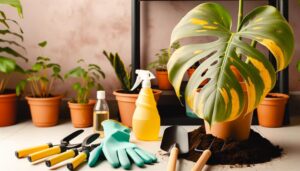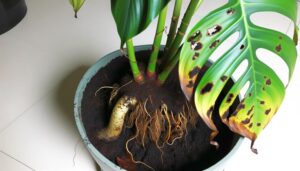What Should I Do if I Find Tiny White Bugs in My Monstera Soil?
If you find tiny white bugs in your Monstera soil, they could be root aphids, springtails, or mealybugs. First, use a magnifying glass to identify them.
Examine the roots and look for signs like chlorosis and stunted growth. Remove the top 2-3 inches of soil and dispose of it.
Treat the soil with imidacloprid for root aphids or use natural remedies like neem oil and diatomaceous earth. Guarantee thorough soil saturation with the chosen treatment.
To prevent future infestations, optimize soil drainage and watering practices. Regular monitoring and proper maintenance will help keep your plant healthy.
Learn more for detailed steps.
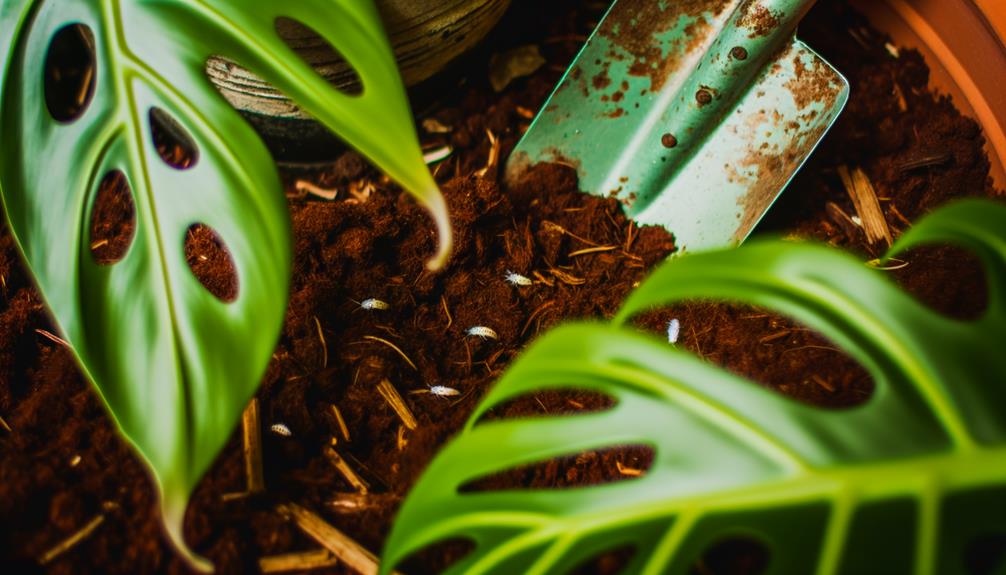
Key Takeaways
- Examine the soil and roots using a magnifying glass to identify the specific type of white bug.
- Gently remove the top 2-3 inches of soil and dispose of it in a sealed bag.
- Treat the soil with insecticidal solutions like imidacloprid or natural remedies such as neem oil.
- Ensure optimal soil drainage and avoid overwatering to prevent pest proliferation.
- Regularly inspect the plant and its soil, wiping leaves with insecticidal soap and rotating the plant.
Identify the White Bugs
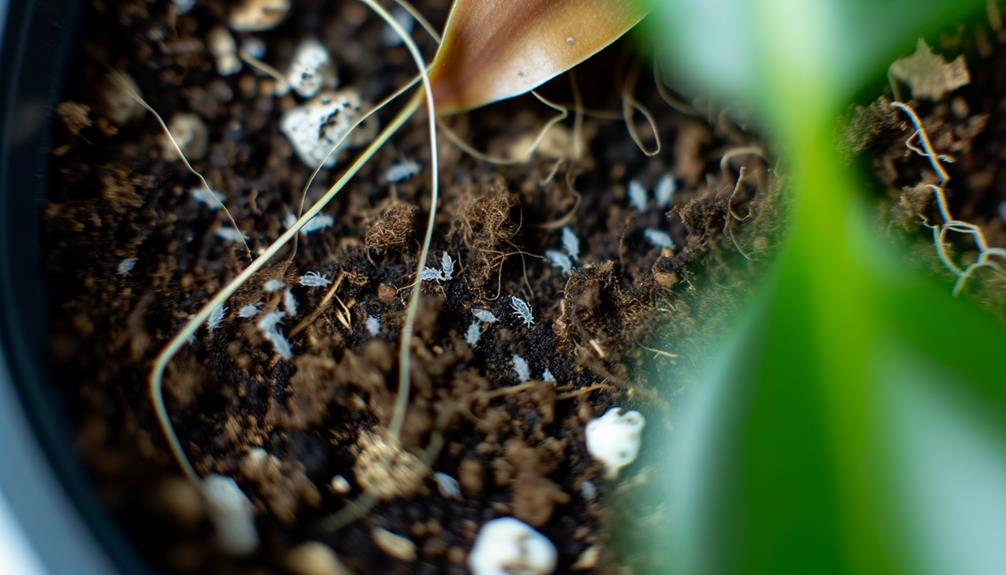
To identify the tiny white bugs in your Monstera soil, closely examine the soil and roots for signs of common pests such as root aphids (Aphis spp.), springtails (Collembola), and mealybugs (Pseudococcidae).
Root aphids are small, often immobile insects that cluster around roots, secreting a sticky honeydew. Springtails are minute, wingless insects that jump when disturbed, thriving in moist environments. Mealybugs appear as cottony masses on roots and stems, excreting a waxy substance that protects them from desiccation.
Use a magnifying glass to observe these pests more clearly. Each pest has distinct characteristics: root aphids have pear-shaped bodies, springtails exhibit a furculum for jumping, and mealybugs are covered in white, wax-like filaments.
Identifying these pests accurately is essential for effective management.
Assess the Damage
Begin by thoroughly inspecting the plant’s health, focusing on any chlorosis, necrosis, or stunted growth that may indicate pest damage.
Next, evaluate soil moisture levels, as excessive dampness can exacerbate infestations of organisms like springtails (Collembola) or root mealybugs (Rhizoecus spp.).
Inspect Plant Health
Carefully examine the Monstera’s leaves, stems, and roots for signs of damage such as chlorosis, necrosis, or distorted growth caused by the infestation of these tiny white bugs, likely root mealybugs (Rhizoecus spp.) or soil mites. Look for yellowing leaves, which indicate chlorosis due to sap extraction by these pests.
Necrosis, or dead tissue, may appear as brown, crispy patches on leaves. Additionally, distorted growth, such as stunted leaves or misshapen stems, can result from nutrient uptake disruption.
Check roots for a white, cottony substance, a hallmark of root mealybugs, which weakens the plant by feeding on root sap. Identifying these symptoms is essential to understanding the extent of the infestation and implementing appropriate treatment measures.
Evaluate Soil Moisture
Evaluating soil moisture is a critical step in determining the extent of damage caused by the tiny white bugs, as overly moist conditions can exacerbate infestations of root mealybugs (Rhizoecus spp.) and soil mites. Begin by inserting your finger about an inch into the soil to gauge moisture levels.
Excessive moisture promotes fungal growth, creating an ideal habitat for these pests. Utilize a moisture meter for a more precise reading. Aim for soil that’s moist but not waterlogged; Monstera deliciosa prefers well-drained soil. Overwatering stresses the plant, weakening its resistance to infestations.
If you find the soil is overly wet, reduce watering frequency and improve drainage by adding perlite or adjusting the potting mix composition.
Identify Bug Type
To accurately identify the tiny white bugs in your Monstera soil, closely examine the pests’ physical characteristics and behaviors under magnification. Look for specific features such as size, body shape, and movement patterns. Common culprits include root aphids (Rhopalosiphum spp.), soil mites (Oribatida), and springtails (Collembola).
| Bug Type | Physical Characteristics | Behavior |
|---|---|---|
| Root Aphids | Small, pear-shaped, translucent bodies | Cluster around roots, slow-moving |
| Soil Mites | Oval, creamy white to light brown | Crawl on soil surface, moderate speed |
| Springtails | Tiny, elongated with a forked tail | Jump when disturbed, high mobility |
Compare your findings with these descriptions to pinpoint the bug type. Identifying the pest correctly will help you determine the appropriate treatment strategy and assess potential damage to your Monstera.
Remove Affected Soil
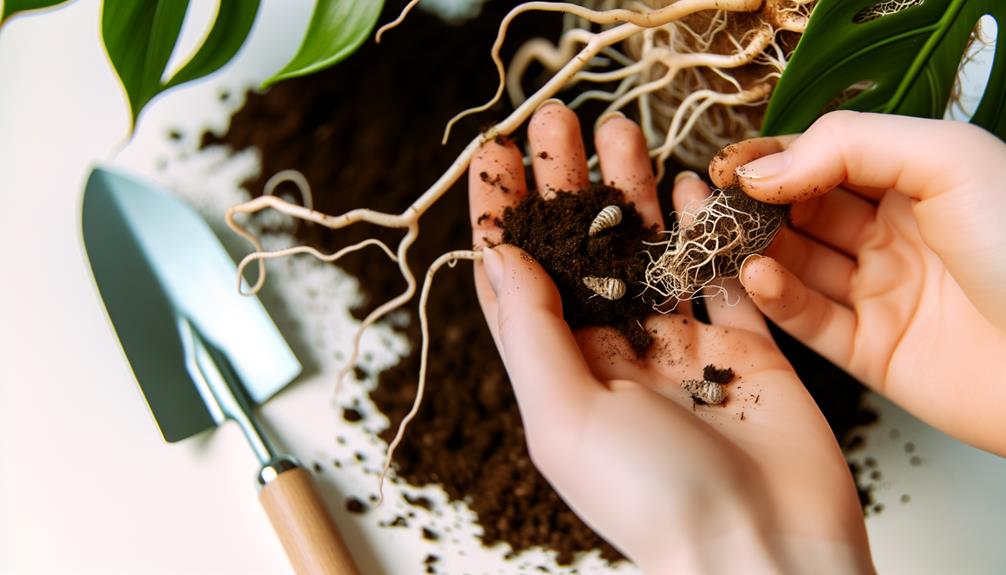
First, remove the affected soil by gently releasing the top 2-3 inches of soil where the presence of tiny white bugs, such as root aphids (Aphidoidea), is most concentrated. Use a sterile spoon or small trowel to carefully lift the soil without damaging the Monstera roots.
- Release soil: Gently loosen and remove the topsoil.
- Inspect roots: Check for any visible signs of infestation on the roots.
- Dispose soil: Place the contaminated soil in a sealed plastic bag to prevent further spread.
Ensure you work meticulously to avoid leaving any infested soil behind. This initial step is essential to reducing the bug population and minimizing their impact on your Monstera’s health.
Treat the Soil
After removing the affected soil, it’s imperative to treat the remaining soil with an insecticidal solution to eradicate any lingering root aphids (Aphidoidea) and prevent re-infestation. Use a systemic insecticide containing imidacloprid, which targets aphids by interfering with their nervous system. Apply according to the manufacturer’s instructions, ensuring thorough soil saturation.
| Insecticide | Active Ingredient | Application Method |
|---|---|---|
| Imidacloprid | Systemic | Soil Drench |
| Azadirachtin | Neem Extract | Soil Drench |
| Pyrethrin | Botanical Insecticide | Soil Drench |
| Bifenthrin | Synthetic Pyrethroid | Soil Drench |
Monitor the soil moisture to prevent waterlogging, which can exacerbate pest problems. Regularly inspect your Monstera for any signs of pest return, ensuring prompt action if necessary.
Natural Remedies
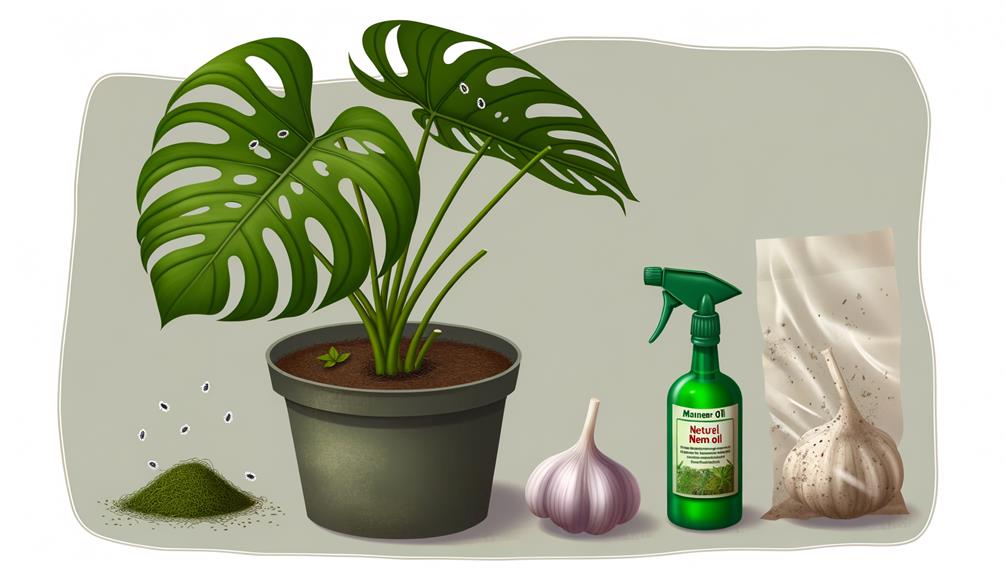
You can effectively manage tiny white bugs in Monstera soil by employing natural remedies like neem oil spray and diatomaceous earth.
Neem oil, derived from Azadirachta indica, acts as an insect growth regulator and disrupts the pests’ reproductive cycle.
Diatomaceous earth, composed of fossilized diatoms, abrasively damages the exoskeletons of insects, leading to dehydration and death.
Neem Oil Spray
Neem oil spray, derived from the seeds of the Azadirachta indica tree, acts as an effective natural remedy against tiny white bugs in Monstera soil by disrupting their hormonal balance and inhibiting their ability to feed and reproduce. The primary active compound, azadirachtin, interferes with the ecdysteroid system, halting insect molting and development.
To apply, mix 1-2 tablespoons of neem oil with water and a few drops of liquid soap to emulsify. Spray thoroughly, ensuring coverage of:
- Soil surface to target larvae and eggs.
- Leaf undersides where bugs often hide.
- Stems and crevices for thorough protection.
Repeat the application every 7-14 days for best results. Neem oil is biodegradable and poses minimal risk to beneficial insects.
Diatomaceous Earth Application
Another natural remedy for combating tiny white bugs in Monstera soil involves using diatomaceous earth, a fine powder composed of fossilized diatoms that mechanically disrupts the exoskeletons of insects, leading to their dehydration and death.
To apply diatomaceous earth (DE), make sure the soil is dry. Sprinkle a thin layer of DE directly onto the soil’s surface, covering the entire area where you’ve observed the pests.
Be sure to use food-grade DE, as it’s safer for indoor use and non-toxic to humans and pets. The sharp microscopic edges of the diatoms cut through the waxy exoskeletons of pests like springtails (Collembola) and fungus gnats (Sciaridae), effectively eliminating them without chemical pesticides.
Reapply after watering.
Chemical Solutions
Incorporating insecticidal soaps containing potassium salts of fatty acids can effectively target and eliminate tiny white bugs, such as root aphids and springtails, infesting Monstera soil. These soaps work by disrupting the cell membranes of the pests, causing dehydration and death. When applying, guarantee thorough coverage of the soil and plant roots.
- Imidacloprid: A systemic insecticide absorbed by roots, targeting pests like Aphis gossypii.
- Pyrethrin: Derived from chrysanthemum flowers, it affects the nervous system of insects.
- Neem Oil (Azadirachtin): Disrupts insect hormone systems, preventing molting and reproduction.
Use these chemicals according to the manufacturer’s instructions to ensure safety and efficacy. Always monitor the plant for adverse reactions and reapply as necessary for complete eradication.
Prevent Future Infestations
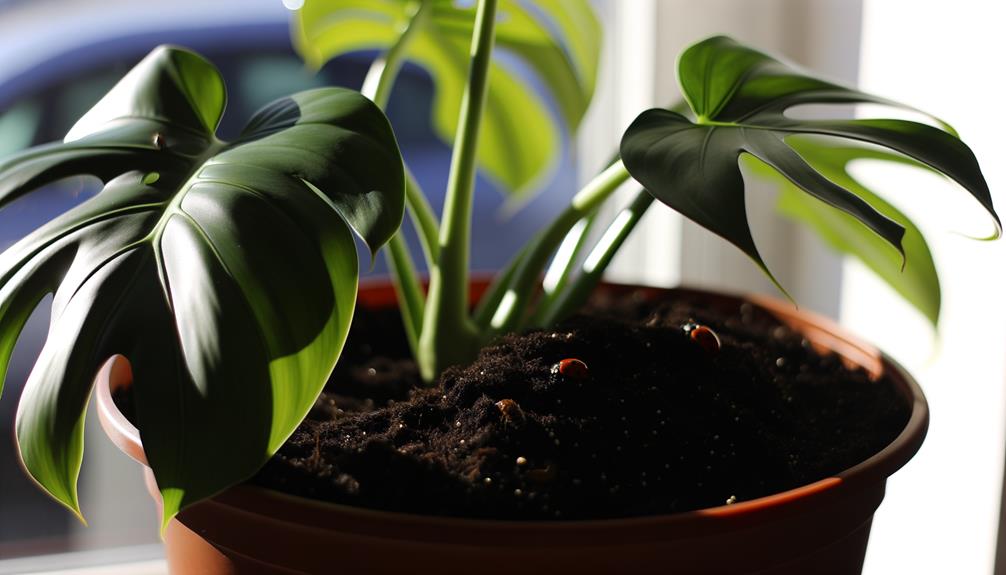
To prevent future infestations of tiny white bugs in Monstera soil, ensure optimal soil drainage and maintain proper watering practices to create an inhospitable environment for pests like Aphis gossypii and Collembola. Confirm your Monstera’s pot has sufficient drainage holes to avoid water accumulation.
Overwatering leads to consistently moist soil, promoting pest proliferation. Utilize a well-draining potting mix, incorporating components such as perlite or orchid bark to enhance aeration.
Regularly inspect the plant for early signs of infestation, focusing on the soil surface and undersides of leaves. Integrate a routine of wiping leaves with insecticidal soap and rotating the plant to different locations to disrupt pest habitats.
These proactive measures will noticeably reduce the likelihood of future infestations.
Conclusion
To sum up, if you find small white bugs like springtails or soil mites in your Monstera’s soil, act promptly. Assess the damage and remove affected soil. Treat the soil using natural remedies or chemical solutions.
Think of your plant as a fortress—defend it diligently to prevent future infestations. Regular monitoring and maintaining best soil conditions will safeguard your Monstera deliciosa, ensuring it thrives without the threat of pests.


